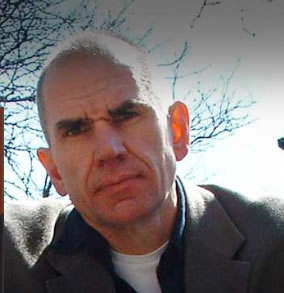The Creation Of Modern Dystopias
A review by Sophie Swithinbank at the Chiswick Book Festival
|
Martin Godleman and Marco Gazic open the session by welcoming everyone to ‘dystopia’ (we are in the Tabard Theatre), and making various jokes about Ed Milliband, drawing the chuckling crowd in cordially.
Godleman throws us in at the dystopian deep-end by reading an extract from his recently published novel, 1909, in which heterosexual relationships are punishable by death and due to a lack pregnancies women are the leading citizens, while men suffer as the underclass. The phrase ‘feminist terrorists’ confuses and intrigues the audience, as Godleman goes onto explain the conception and birth of his book. Godleman acknowledges that male authors have largely occupied the dystopian genre. This makes the subversion of gender in his novel all the more exciting and controversial as we see a dystopia where women are at the forefront of every sector.

Martin Godleman
Having taught English in a school in south London for fifteen years, Godlemen is passionate about getting young minds ticking in the direction of the future. He expresses his joy that Margaret Atwood’s The Handmaid’s Tale is now on the AQA English Literature syllabus and will be read and digested by thousands of teens across the UK for the next decade or so. He is pleased that such a powerful and dissident female mind is being made available to young people nationwide.
Godleman’s discussion of modern dystopias is an immediately engaging one. With an anecdote about the recent discontinuation of a teaching course that was thought to be promoting homosexual relationships and ‘pretend love’, he expends on the audience his theory that dystopias are continuously created in our modern society.
Godleman explains the outrage he felt when he realised that society and education were being built around the idea that it is wrong to fall in love with someone of the same gender. This led him towards his idea for 1909, where society is built around homosocial and homosexual relationships and leaders are disgusted by the idea of heterosexuality. Marco Gazic introduces another subversion in the dystopian genre. He outlines ideas from Yevgeny Zamyatin’s We, which follows the story of a dystopia masked as a utopia. Written almost three decades before George Orwell’s 1984, Zamyatin realises the notions of dystopic numbering and ordering of people in a world where everyone lives in fragile glass houses with no privacy. This outlines how dystopian fiction has developed since its beginning when John Stewart Mill coined the term in 1868, moving on to Huxley, Orwell and – most importantly, Godlemen argues - Margaret Atwood. The Handmaid’s Tale and Oryx and Crake are recommended highly by Godlemen, Gazic and various keen audience members.
At the close of the session, during the Q&A, an audience member asks, ‘Why did dystopian fiction take over from utopian fiction?’ And the simple answer is, having spent an hour assessing some of the best old and new dystopic novels available, that utopian fiction is simply boring (apologies to Sir Thomas More). Nobody wants to read about a community where only good things happen. Bring on Godleman and his bleakness, death and dissidence in the modern world of fiction.
Sophie Swithinbank
September 18, 2015